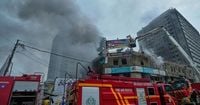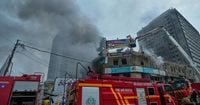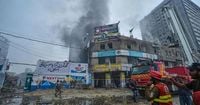On a bustling Thursday afternoon, chaos erupted in Karachi, Pakistan’s largest city, when a fireworks warehouse exploded, leaving at least 34 people injured and sparking panic along the busy streets of the southern port metropolis. The incident, which unfolded on August 21, 2025, brought the city’s commercial heart to a standstill as thick smoke billowed from the multi-storey building and smaller blasts echoed in the aftermath, according to Reuters and the Associated Press.
The blast, which occurred in a fireworks storage facility located on Jinnah Road—a well-known commercial area—sent shockwaves through the neighborhood. Residents and shopkeepers, many caught off guard by the sudden eruption, described scenes of pandemonium as they scrambled to escape the area. "I thought several bombs have exploded," resident Aqib Khan told reporters, capturing the confusion and terror that gripped the crowd in those first moments.
Television footage aired by local channels, including Geo News, showed people running for safety, some abandoning their vehicles and others helping the injured. The force of the explosion shattered glass in neighboring shops, sending shards raining onto passersby and littering the road with debris. Several vehicles passing through the area at the time were also damaged, further complicating rescue efforts and adding to the sense of disorder.
Firefighters raced to the scene as smoke poured from the building where the firecrackers were stored. The blaze quickly spread, engulfing the warehouse and several nearby shops. Fire crews worked tirelessly to bring the flames under control, while ambulances rushed to transport the injured to local hospitals. Police official Summaiya Tariq confirmed to Reuters that at least 34 people were admitted for treatment, with four in critical condition. Senior police official Asad Raza told the Associated Press that the injured included both bystanders and those working in the affected shops.
Witnesses described a scene of panic as people fled the area, fearing further explosions. "Broken glass from nearby shop windows littered the road as panicked residents rushed from the scene," the Associated Press reported, citing eyewitness accounts. Closed-circuit camera footage captured the frantic moments following the blast, with motorists hastily reversing their vehicles and pedestrians sprinting away from the danger zone.
The impact of the explosion was felt well beyond the immediate vicinity. Karachi, home to more than 20 million people and considered Pakistan’s financial capital, is no stranger to industrial accidents and urban emergencies. But Thursday’s blast was especially jarring, coming just one day after intense monsoon rains had already flooded the city and strained emergency services. The timing only compounded the challenges faced by first responders, who were already stretched thin by the deluge.
Despite the dramatic scenes and significant damage, authorities were quick to state that the cause of the explosion remained unclear. Both Reuters and the Associated Press noted that there was no immediate indication of what triggered the initial blast. However, the incident is part of a troubling pattern in Pakistan, where explosions at fireworks facilities have become alarmingly common. In January 2025, for example, a similar blast at a fireworks storage site in Mandi Bahauddin, located in the eastern Punjab province, claimed the lives of six people.
The frequency of such incidents has raised questions about safety standards and regulatory oversight in the country’s booming fireworks industry. Warehouses and storage facilities often operate in densely populated urban areas, sometimes with inadequate fire safety measures and limited enforcement of existing regulations. The Karachi blast, which damaged multiple shops and vehicles in addition to injuring dozens, has once again highlighted the risks posed by these operations.
As the immediate danger subsided and firefighters gained control of the blaze, attention turned to the aftermath. The road outside the warehouse remained strewn with broken glass and debris, a stark reminder of the explosion’s force. Shopkeepers and residents surveyed the damage, many shaken by how quickly an ordinary afternoon had turned into a scene of devastation. Local hospitals, meanwhile, worked to treat the injured, some of whom had suffered severe burns or lacerations from flying glass.
Despite the chaos, there were moments of solidarity and resilience. Bystanders assisted emergency workers in guiding people to safety and helping the wounded. Ambulance drivers navigated clogged streets to reach hospitals as quickly as possible, while firefighters braved the risk of further explosions to contain the blaze. Karachi’s residents, accustomed to adversity, banded together in the face of yet another urban disaster.
The incident also reignited debate about Karachi’s broader vulnerability to industrial accidents and the challenges of managing public safety in a sprawling megacity. With its dense population, aging infrastructure, and frequent power outages, Karachi faces unique risks when it comes to emergencies like fires and explosions. The city’s rapid growth has often outpaced the development of adequate safety protocols, leaving many neighborhoods exposed to hazards from poorly regulated businesses and warehouses.
Officials have promised a thorough investigation into the cause of the blast, but as of Thursday evening, no official explanation had been offered. Both police and fire authorities indicated that determining the source of the explosion could take time, given the extensive damage and ongoing recovery efforts. In the meantime, questions lingered about whether the tragedy could have been prevented—and what steps might be taken to avoid similar disasters in the future.
For many in Karachi, Thursday’s explosion was a grim reminder of the city’s ongoing struggles with safety and infrastructure. Yet even as the smoke cleared and the injured received care, there was a sense of determination to rebuild and recover. The resilience of Karachi’s people, tested time and again by floods, fires, and other crises, was once again on display as the city began the slow process of healing.
As Karachi looks ahead, the hope is that lessons learned from this latest tragedy will lead to stronger safety measures and better protection for its citizens. For now, though, the scars left by the explosion serve as a somber testament to the risks that linger just beneath the surface of everyday life in Pakistan’s largest city.



